

Integrating a patio deck with your landscaping design is crucial for creating a cohesive and inviting outdoor space. A well-integrated deck adds beauty, value, and functionality to your home. However, many homeowners struggle with balancing the deck with existing landscaping elements, leading to a disjointed and unappealing aesthetic. This comprehensive guide will explore how to achieve a harmonious integration, covering everything from design considerations to material choices, helping you create a stunning outdoor living area. This article will walk you through each step of the design process, offering practical tips and inspiration along the way.
Understanding the Importance of Patio Deck Integration
The Psychology of Patio Deck Integration
A well-integrated patio deck isn’t just about aesthetics; it’s about creating a seamless transition between indoors and outdoors. Psychologically, a cohesive space creates a sense of flow and comfort, extending the living area beyond the traditional boundaries of the house. This flow can enhance the user experience, making the outdoor area feel more inviting and usable. A poorly integrated design, on the other hand, can create a sense of disharmony and disconnect.
Creating a Cohesive Outdoor Living Experience
A professionally designed patio deck offers more than just an extension of the home; it’s a conscious design choice to create an inviting atmosphere. A well-planned landscape design encompasses the elements of the outdoor area, including the deck, to create a balanced visual experience, whether it’s a patio, gazebo or pergola, these elements work in harmony with the surroundings. Furthermore, the careful consideration of materials, lighting, and furniture choices contribute to the overall feel and ambiance.
The Visual Impact of Harmonious Integration
Integrating a patio deck with your landscaping design ensures that the deck complements the existing landscape, rather than clashing with it. This is achieved through the mindful selection of materials and the strategic placement of plants, pathways, and other landscaping features. Imagine a deck made of weathered wood, complementing a naturalistic garden design. The result is a harmonious aesthetic that flows naturally throughout the space.
Choosing the Right Deck Materials
Material Selection Criteria
The choice of deck materials plays a pivotal role in the overall integration with landscaping. Consider durability, maintenance, and your budget. Natural materials like wood, composite decking, or even concrete offer unique characteristics. For example, a cedar deck complements a woodland-style landscape perfectly, while a composite deck offers low-maintenance benefits. Analyze your local climate and the frequency of cleaning needed to make an informed decision. Also, consider the color and texture of the materials when selecting, ensuring they align with your desired aesthetic.
Materials for Budget-Friendly Solutions
Budget constraints don’t mean compromising on aesthetics. Composite decking is a popular choice for its resilience and longevity, which translates to substantial cost savings in the long run. It also minimizes maintenance and weathering issues, making it a practical choice for a variety of outdoor environments.
Integrating Materials with Existing Landscaping
Consider existing materials in your landscaping when selecting materials for your deck. If your garden features stone pathways, consider using stone or wood that complements the stone work. This will help avoid visual inconsistencies and reinforce the theme of continuity throughout the space. This approach allows for seamless transitions and avoids disrupting the harmonious flow between the landscape and your deck.
Strategic Landscaping Design Principles
Layout and Flow Considerations
Strategic placement of plants, lighting, and other landscaping features around the deck creates a welcoming atmosphere. Think about how people will use the space and create a flow that encourages natural movement. Consider adding pathways to guide guests from the main entrance to the patio. The location of the patio can influence how the landscaping design needs to be shaped.
Planting and Placement for Optimal Visual Impact
Strategically positioning trees and shrubs around the deck can enhance the aesthetic appeal of your landscape. Consider using plants that create visual interest and frame the deck to create focal points and visual hierarchy. Consider native plants for a harmonious approach.
Lighting Design for Evening Ambiance
Lighting is a crucial aspect of evening ambiance. Pathway lights, spotlights, and string lights can illuminate the deck area at night, creating a warm and inviting atmosphere. A lighting plan is essential to creating the perfect lighting and emphasizing landscaping features.
Incorporating Furniture and Accessories
Choosing the Right Furniture
Patio furniture is an important addition to any outdoor living space. Select furniture that matches your style and complements the materials used for the deck and landscaping. Outdoor seating should be comfortable and durable, matching the aesthetic and style of your outdoor living area.
Incorporating Accessories for Added Functionality and Style
Think about elements like outdoor rugs, decorative pillows, and outdoor lighting to enhance the atmosphere and functionality of the space. Consider incorporating elements that match your existing landscaping or deck materials. This can help to create a cohesive look and feel for the entire space.
Creating a Multi-Functional Space
Ensure your furniture choices cater to both relaxation and socializing. Design the space to create a welcoming area for gatherings, or for quiet relaxation. Consider space and functionality of furniture pieces for maximum use.
Maintaining Your Patio Deck and Landscaping
Preventing Damage and Rot
Regular maintenance is essential for preserving the aesthetic appeal and longevity of both the patio deck and your landscaping design. Proper care for the deck, such as sealing and cleaning, is crucial. Regular inspections and cleaning of the landscaping features will prevent potential problems.
Enhancing the Curb Appeal of Your Patio Deck
Consistent cleaning, upkeep of plants, and timely pruning of shrubs and trees are crucial for a beautiful and well-maintained outdoor area. Keep in mind that a well-maintained landscape enhances curb appeal and extends the life of your investment.
Long-Term Considerations for Your Outdoor Space
Plan for future needs and changes to your outdoor space. This will help you preserve your investment and allow you to adapt your design as your needs change.
Case Studies and Examples
Successful Integration in Residential Settings
Explore various approaches used in different residential projects, focusing on the effective use of landscaping for enhancing patio decks. Analyze how similar projects have addressed the issue of integrating existing landscaping with a new deck.
Landscape Design and Patio Decks in Different Climates
Examine how designers have adapted their designs to various climates, focusing on how material selection and landscaping choices contribute to the success of the integration in different environments. For instance, how does arid landscaping differ from a tropical landscape setting
Successful Integration Strategies for Achieving Cohesion
Look into how designers have tackled similar challenges in their projects to offer valuable insights for creating cohesive designs that integrate the deck and landscaping. Use these design principles and strategies to inform your own approach.
FAQ:
What are some budget-friendly ways to integrate a patio deck with my landscaping?
Budget-friendly solutions include using readily available materials like composite decking, opting for simpler design elements, and DIY projects. Consider repainting existing structures, or exploring landscaping techniques that accentuate the deck without major renovations. Recycling materials from existing structures can be another smart and budget-conscious approach.
How can I ensure the patio deck seamlessly blends with my existing landscaping?
Consider the existing plants, hardscapes, and colors in your current design. Try matching the deck materials to existing elements for a cohesive look. For instance, use similar tones and shades in the decking material as found in the surrounding structures. Maintain continuity in the lines and shapes for an aesthetically pleasing integration. Use strategic plant placements to frame the deck and create visual harmony with your existing landscape.
What are the essential factors to consider when choosing materials for a patio deck?
Durability, maintenance, and aesthetic appeal are paramount considerations when selecting materials. Look into the resistance of different types of materials to weather conditions, and how easy they are to clean. Consider your budget and the environmental impact of your choice. Also, be mindful of the material’s ability to complement your existing landscaping and your personal style.
How can I make my patio deck accessible to people with disabilities?
Accessibility features should be incorporated into the design from the outset. Compliance with accessibility standards is crucial. Ensure that the deck meets accessibility standards for ramps, handrails, and pathways, and consider wider walkways. This ensures safety and comfort for everyone. Seek professional guidance on complying with applicable building codes and accessibility regulations.
In conclusion, integrating a patio deck with your landscaping design is a fantastic way to enhance both the aesthetic appeal and the functionality of your outdoor space. By carefully considering the design elements, materials, and the overall flow of your landscaping, you can create a cohesive and inviting outdoor living area. Remember to prioritize practicality, sustainability, and your personal style throughout the design process. For a truly exceptional result, consider consulting with a landscape architect or designer. Don’t hesitate to explore further and discover how you can transform your patio deck into a beautiful and functional extension of your home.